
The Revolutionary Armed Forces of Colombia – People's Army is a Marxist–Leninist guerrilla group involved in the continuing Colombian conflict starting in 1964. The FARC-EP was officially founded in 1966 from peasant self-defense groups formed from 1948 during the "Violencia" as a peasant force promoting a political line of agrarianism and anti-imperialism. They are known to employ a variety of military tactics, in addition to more unconventional methods, including terrorism.

Íngrid Betancourt Pulecio is a Colombian politician, former senator and anti-corruption activist, especially opposing political corruption.
Simón Trinidad is the alias of Juvenal Ovidio Ricardo Palmera Pineda, a high-ranking member of the Revolutionary Armed Forces of Colombia (FARC), and reputedly the first high-ranking member of that guerrilla group to be captured. "Simón Trinidad" is currently serving a 60-year sentence in solitary confinement in the United States at ADX Florence "Supermax" prison near Florence, Colorado with a scheduled release date of February 17, 2055.

The National Liberation Army is a Marxist–Leninist guerrilla insurgency group involved in the continuing Colombian conflict, which has existed in Colombia since 1964. The ELN advocates a composite communist ideology of Marxism-Leninism and liberation theology. In 2013, it was estimated that the ELN forces consisted of between 1,380 and 3,000 guerrillas. According to former ELN national directorate member Felipe Torres, one fifth of ELN supporters have taken up arms. The ELN has been classified as a terrorist organization by the governments of Colombia, the United States, Canada, New Zealand, and the European Union.

Julio César Turbay Ayala was a Colombian lawyer and politician who served as the 25th President of Colombia from 1978 to 1982. He also held the positions of Foreign Minister and Ambassador to the United States.
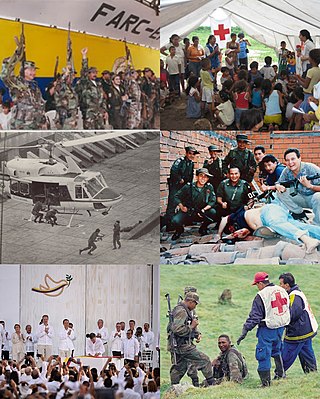
The Colombian conflict began on May 27, 1964, and is a low-intensity asymmetric war between the government of Colombia, far-right paramilitary groups and crime syndicates, and far-left guerrilla groups, fighting each other to increase their influence in Colombian territory. Some of the most important international contributors to the Colombian conflict include multinational corporations, the United States, Cuba, and the drug trafficking industry.

Guillermo León Sáenz Vargas, more commonly known by his nom de guerre Alfonso Cano, was the commander of the militant group known as Revolutionary Armed Forces of Colombia. He succeeded founder Manuel Marulanda in March 2008 and commanded the Marxist rebel group until being killed in action by the Colombian Army.
The Revolutionary Armed Forces of Colombia (FARC–EP) is a Marxist–Leninist revolutionary guerrilla organization based in Colombia, which is involved in the ongoing Colombian armed conflict.
Ricardo González also known as Rodrigo Granda is a Colombian Venezuelan, member of Revolutionary Armed Forces of Colombia (FARC). He has served as international spokesman of the guerrilla organization. He currently faces criminal charges in Paraguay for his alleged involvement from an intellectual and logistic angle in the kidnapping and subsequent murder of Cecilia Cubas, daughter of former President Raúl Cubas.
The Western Bloc of the Revolutionary Armed Forces of Colombia was the smallest of the Revolutionary Armed Forces of Colombia's (FARC) blocs in size, although not in military capability. It was often held responsible for attacks that occurred in Cali and the surrounding area. The specific divisions of the group are arguable. Some of its divisions or fronts, as they were commonly known as, are shown below. Many of these fronts worked together at times towards a certain mission, while others were further divided into columns and companies with a smaller number of members. For more general information, see FARC-EP Chain of Command.
The FARC-Government peace process (1999–2002), from January 7, 1999, to February 20, 2002, was a failed peace process between the Government of President Andrés Pastrana Arango and the Revolutionary Armed Forces of Colombia (FARC) guerrilla group in an effort to bring to an end the ongoing Colombian armed conflict.
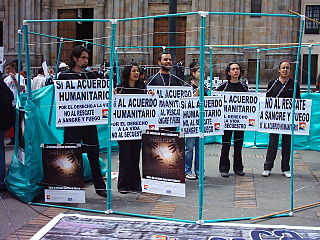
Kidnappings in Colombia refers to the practice of kidnapping in the Republic of Colombia. This criminal practice was first introduced in modern Colombian history during the early 1970s by the guerrilla movements and, later, also by criminal groups. With the release of Colombian presidential candidate Ingrid Betancourt on July 2, 2008 this practice gained worldwide notoriety.
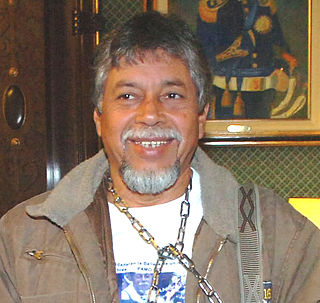
Gustavo Guillermo Moncayo Rincón, popularly known as El caminante por la paz, was a Colombian teacher who in 2007 walked 1,186 km from his hometown Sandoná, in the department of Nariño in the south of Colombia to the capital city Bogotá, seeking to promote an agreement for the release of his son Pablo Emilio who had been a prisoner of the guerrilla group FARC since 1997.
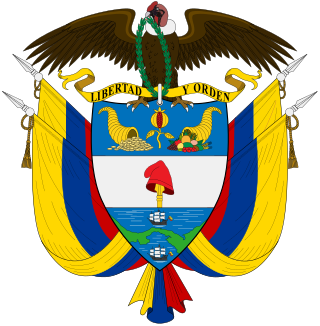
This is a timeline of events related to the Colombian armed conflict.
The Department Assembly of Valle del Cauca is the department assembly of the Colombian Valle del Cauca Department. The assembly is part of the Colombian legislative branch of government at a Provincial level and its main function is to debate, approve or change the local ordinances.

The Humanitarian Exchange or Humanitarian Accord referred to a possible accord to exchange hostages for prisoners between the Revolutionary Armed Forces of Colombia (FARC) guerrilla group and the Government of Colombia.
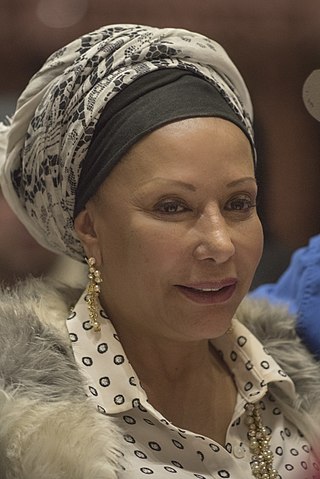
Piedad Esneda Córdoba Ruiz was a Colombian lawyer and politician who served as a senator from 1994 to 2010. A Liberal Party politician, she also served as a member of the Chamber of Representatives of Colombia for Antioquia from 1992 to 1994.
Operation Emmanuel was a humanitarian operation that rescued politician Clara Rojas, her son Emmanuel, and former senator Consuelo González from the Revolutionary Armed Forces of Colombia (FARC) in Colombia. The operation was proposed and set up by Venezuelan President Hugo Chávez, with the permission of the Colombian government of Álvaro Uribe. Chávez's plan was supported by the governments of Argentina, Bolivia, Brazil, Ecuador, and France, as well as the Red Cross, which also participated in the operation. Venezuelan aircraft were flown to an airport in the Colombian town of Villavicencio, were resupplied, and from there flew to the secret rescue point set up by the FARC. On December 26, 2007, through the Minister of Foreign Affairs, the Colombian government approved the mission, only requesting that the aircraft used for the operations were labelled with Red Cross insignias.
Sigifredo López Tobón is a lawyer and politician. While deputy in the administrative department of Valle del Cauca he was kidnapped by the Revolutionary Armed Forces of Colombia (FARC) in 2002. After surviving a massacre of 11 of his fellow deputies, also kidnapped, on 18 June 2007, he was released on February 5, 2009.










